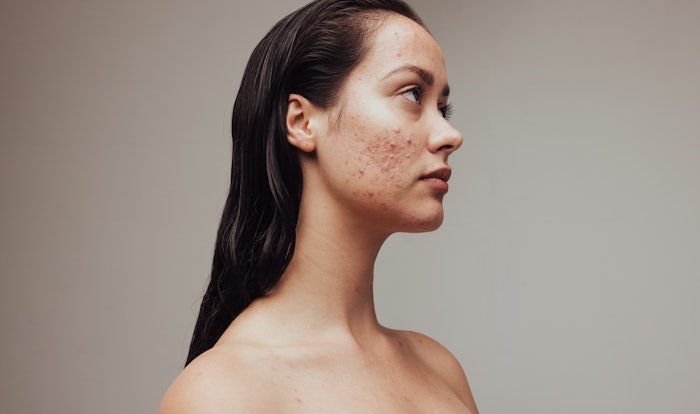
Once you’ve learned to spot the early signs of acne, the next step is understanding why it’s happening and how to intervene in a way that respects the skin’s balance to effectively treat-pre-acne. From tracking blemish history to identifying overlooked lifestyle triggers, today’s estheticians are digging deeper to help clients prevent breakouts before they begin. A proactive approach—one that considers internal and external factors alike—can be the key to maintaining lasting skin clarity and resilience.
Blemish History and Early Signs of Pre-Acne Skin
Understanding a client's blemish history can be key to preventing future breakouts and treating pre-acne. Take note of where and when blemishes tend to appear—whether it's hormonal breakouts along the jawline, congestion in the T-zone or stress-related flare-ups. Tracking patterns over time can help identify triggers like diet, skin care products or lifestyle habits. This self-awareness allows both professionals and clients to take proactive steps when early warning signs return, rather than waiting for a full breakout to develop.
In part I, we established that the earliest signs of a developing breakout start with subtle shifts in the skin's texture. This early activity beneath the surface isn’t just skin-deep—it can often reflect what’s happening inside the body as well. Cassie Ressler, aesthetic director at Integra Health & Wellness, takes a whole-body approach to skin care, seeking to treat skin from the inside out. “From a holistic perspective, acne is often a symptom of systemic inflammation,” she explains. Drawing from traditional Chinese medicine, Ressler uses face mapping to try and interpret how different areas of the skin reflect the health of specific internal organs. Ressler and others like her, look to the location and pattern of breakouts on the face for insight into underlying internal factors. For example, breakouts on the forehead may indicate digestive issues, while blemishes along the jawline might signal hormonal imbalances. By paying attention to these facial zones, some professionals try to better understand the root causes of skin imbalances and tailor treatments to address the body’s internal needs.
Lifestyle Factors and Pre-Acne Skin
Lifestyle factors play a powerful but often underestimated role in the development of pre-acne conditions. Habits like stress, poor sleep and diet can quietly influence skin balance and trigger early signs of breakouts, especially for teens. Small, consistent shifts in daily routines can make a noticeable difference in keeping skin calm and clear.
“Athletes, in particular, need to be mindful of their gear,” says Melissa Costanzo, a licensed esthetician at Salma Simjee MD, Dermatology. “Helmets, hats and dirty equipment can trap sweat and bacteria against the skin, leading to congestion. Showering after practice, changing pillowcases regularly and using clean towels all matter—don’t dry your face with the family hand towel!” Consistent hygiene routines make a meaningful difference.
Ressler explains that the gut-skin axis can act as an early warning system, especially when stress or unresolved emotions like frustration or anger trigger an inflammatory response in the body. She encourages clients to check in with themselves daily, asking, “What’s causing me stress right now? What do I need to release from today?” Stress can trigger hormonal shifts that increase oil production and inflammation. Managing stress is different for everyone, but it’s worthwhile to explore options. Some people find that gentle exercise like walking or yoga helpful for managing stress. Journaling or therapy might also help with managing difficult emotions. Of course, eliminating stress is an effective way to solve the problem, but isn’t always possible in the short term.
Lack of sleep is another issue, which disrupts skin regeneration and repair. A cool, dark, quiet room is essential, while a white noise machine or fan can help lull night owls to sleep. Clients should aim for 8 hours, and adjust as needed. A special note about phones and other electronic devices: their light on our retinas is very disruptive to restful sleep, so people should avoid scrolling for about an hour before bedtime. Also, advise clients to try and have their last meal or snack 2-3 hours before retiring for the evening.
Diet is definitely a factor for many people when it comes to acne prevention and treating pre-acne. Diets high in sugar, dairy and gluten can contribute to congestion in acne-prone individuals. These food sensitivities increase internal mucus production. “Supportive tools like dry brushing and light movement to stimulate lymphatic flow may help reduce inflammation, balance hormones and promote clearer skin over time,” says Ressler. Addressing these factors holistically can help prevent breakouts before they start.
Shirvandehi adds, “Choose complex carbs when possible, rather than simple carbs. Fruits, vegetables, whole grains and beans are excellent. Brown rice instead of white, sweet potatoes rather than russets. The fewer processed foods consumed the better.” Most important are the inflammatory oils. Clients should avoid corn oil, vegetable oil, shortening and canola oil in favor of coconut oil, olive oil, ghee and avocado oil. Butter can also be used in moderation. Even lard, once thought to be the epitome of poor health, is actually fine for frying. All sorts of meat and fish can be eaten, especially fish high in omega-3 fatty acids such as salmon.
Staying hydrated, managing stress, getting consistent rest and maintaining a balanced, anti-inflammatory diet can all help reduce the internal triggers that push the skin toward breakouts.
Additional Causes and Treatments for Pre-Acne Skin
Some of the most common causes of skin congestion and irritation are also the most overlooked when treating pre-acne skin. Heavy or occlusive skin care products, dirty makeup brushes and buildup from hair products along the hairline can all contribute to clogged pores. “Skin dehydration and dryness trapped by comedogenic products will continually cause blemishes. Ingredients to watch out for include heavy oils, emollients, silicones and emulsifiers, which can create a film that blocks pores and worsens congestion,” Ressler adds. Under or over-cleansing or exfoliating too often can disrupt the skin barrier, triggering inflammation and compensatory oil production. Environmental stressors like infrequently washed pillowcases or towels, pollution, sweat and even hard water can also quietly aggravate the skin over time. These subtle factors can prime the skin for breakouts long before blemishes become visible.
Costanzo notes how social media trends can tempt clients to try too many products at once, but it's best to patch test and introduce new items one at a time. Many acne treatments contain strong ingredients like benzoyl peroxide or salicylic acid, which can irritate when overused. If prescribed something stronger like tretinoin or adapalene, clients should be sure to moisturize and wear sunscreen to avoid dryness and sensitivity. According to Ressler, a great place to start is by treating the gut-skin axis by taking a supplement like Skin Moderne’s i/o Beauti. This can help balance and regulate the inflammatory response in the gastrointestinal tract. “This is a great place to start so that the skin is not inflamed or irritated, further disrupting the skin’s microbiome. Also hydration—balancing the skin barrier helps minimize or prevent the tiny bumps and textural irregularities that lead to acne,” says Ressler.
"It’s also important to use products without pore cloggers. Just because a product says it’s ‘non-comedogenic’ doesn’t mean this is true. This term on product packages and advertising is not regulated—any brand can say basically whatever they want! Seek professional advice when in doubt,” says Shirvandehi. Also, clients should keep in mind that using a gentle moisturizer is better than trying to “dry out” the acne. Hydrated skin is less likely to break out. It's also crucial to use non-clogging, physical sunscreen daily. Clients should look for zinc and titanium oxide, with an SPF of at least 30, because sun damage can actually exacerbate clogging.
Seeking Treatment for Pre-Acne Skin
Encourage clients to rely on you or a trusted colleague as a resource for treating pre-acne and acne. Acne specialists are equipped to evaluate clients' skin care products and lifestyles. They can help identify and replace any products that don't help keep skin clearer. They'll also have access to the best products designed to keep skin clear, and they've already done the research. This will save time and money in the long run, as consumers won’t be buying products based on TikTok “experts,” paid influencers or strategically placed store advertisements.










